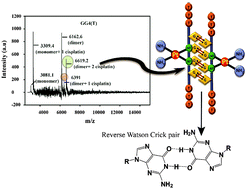Reverse Watson–Crick G–G base pair in G-quadruplex formation†
Abstract
A stable intermediate dimeric G-rich form as a precursor of tetrameric G-quadruplex structures has been detected via MALDI-TOF spectrometry. Molecular dynamics simulation offered detailed insights at the atomic level, assigning reverse Watson–Crick G–G base pairing (not Hoogsteen) in the G-rich dimer. In support of this, cisplatin formed a stable adduct by binding to the dimeric G-rich structure, eliminating the possibility of G–G Hoogsteen hydrogen bond formation.

- This article is part of the themed collection: Chemical Biology in Molecular BioSystems

 Please wait while we load your content...
Please wait while we load your content...